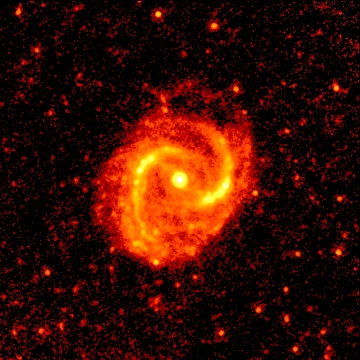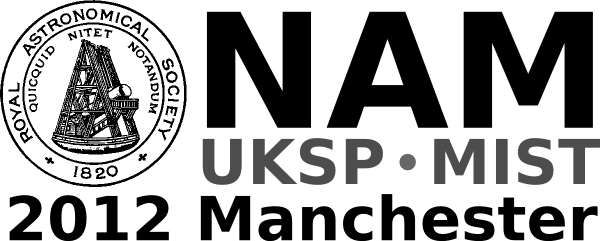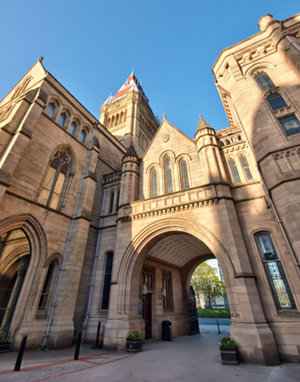UK-Germany National Astronomy Meeting NAM2012
Public to get access to spectacular infrared images of galaxies
Royal Astronomical Society press release
RAS PR 12/12 (NAM 3)
Tuesday 27 March 2012

The mid-infrared (24 micron) image of M91 as seen with the Spitzer Space Telescope. M91 is the prototype example of a barred spiral galaxy. Although the spiral arms are easily seen in mid-infrared light, the bar is only faintly visible.
For the first time, the general public will be able to browse detailed infrared images of more than 200 galaxies. The pictures, originating from data from the orbiting Spitzer Space Telescope, will be released later this year. Dr George Bendo of the Jodrell Bank Centre for Astrophysics will highlight the new imagery in a preview at the National Astronomy Meeting in Manchester.
The pictures are mid-infrared (24 micron wavelength) reprocessed images of nearby galaxies observed with Spitzer between 2003 and 2009. Amongst the images are the galaxies M60, M61, M88, M91 and M98, all of which lie between 47 and 63 million light years away in the large cluster of galaxies found in the direction of the constellation of Virgo.
The mid-infrared light from these galaxies primarily traces interstellar dust heated by the hot young stars found in the places where stars are forming. The images, which are being made available to the public for the first time, are a small sample of those that will be released later in the year.
Dr Bendo explains how complicated it was to make the data usable for science. "The 24-160 micron Spitzer images need expert processing to be suitable for scientists, let alone the general public and until now many of them had been overlooked. I volunteered to do this work for these galaxies as they will soon be observed by the Herschel Space Observatory at far-infrared wavelengths. With processed Spitzer data, astronomers will be able to make a direct comparison between the views from each telescope."
He is delighted to be bringing the Spitzer material to the public: "These data show the intimate connection between the interstellar dust in galaxies, here seen shining in infrared light, and the formation of stars on a grand scale. Now anyone with Internet access can download these extraordinary pictures for themselves and take a look at some of the objects being studied by the world's leading astronomers, as part of their effort to better understand the universe we live in."
IMAGES
Images and captions are available from Jodrell Bank Centre for Astrophysics at http://www.jb.man.ac.uk/news/2012/Spitzer/ and http://www.jb.man.ac.uk/news/2012/Spitzer/ and from the Herschel Database in Marseille at http://hedam.oamp.fr/
MEDIA CONTACTS
NAM 2012 Press Office (0900 - 1730 BST, 27-29 March; 0900 - 1630 BST 30 March)
Room 3.214
University Place building
University of Manchester
Manchester
UK
Tel: +44 (0)161 306 7313
Dr Robert Massey
Royal Astronomical Society
Mob: +44 (0)794 124 8035
Email: rm@ras.org.uk
Anita Heward
Royal Astronomical Society
Mob: +44 (0)7756 034 243
Email: anitaheward@btinternet.com
Dr Klaus Jaeger
Pressereferent / Press Officer im Vorstand der Astronomischen Gesellschaft
Tel: +49 6221 528 379
Email: pressereferent@astronomische-gesellschaft.de
Dan Cochlin
Media Officer (Faculty of Engineering and Physical Sciences)
University of Manchester
Tel: +44 (0)161 275 8387
Email: daniel.cochlin@manchester.ac.uk
SCIENCE CONTACTS
George Bendo
Jodrell Bank Centre for Astrophysics
University of Manchester
United Kingdom
Tel: +44 (0)161 27 54258
Email: george.bendo@manchester.ac.uk
NOTES FOR EDITORS
NAM 2012
Bringing together more than 900 astronomers and space scientists, the National Astronomy Meeting (NAM 2012) will take place from 27-30 March 2012 in the University Place conference centre at the University of Manchester in the UK. The conference is a joint meeting of the Royal Astronomical Society (RAS) and the German Astronomische Gesellschaft (AG) and is held in conjunction with the UK Solar Physics (UKSP: www.uksolphys.org) and Magnetosphere Ionosphere Solar Terrestrial (MIST: www.mist.ac.uk) meetings. NAM 2012 is principally sponsored by the RAS, AG, STFC and the University of Manchester.
The Royal Astronomical Society
The Royal Astronomical Society (RAS: www.ras.org.uk), founded in 1820, encourages and promotes the study of astronomy, solar-system science, geophysics and closely related branches of science. The RAS organises scientific meetings, publishes international research and review journals, recognizes outstanding achievements by the award of medals and prizes, maintains an extensive library, supports education through grants and outreach activities and represents UK astronomy nationally and internationally. Its more than 3500 members (Fellows), a third based overseas, include scientific researchers in universities, observatories and laboratories as well as historians of astronomy and others.
The Astronomische Gesellschaft (AG)
The Astronomische Gesellschaft (AG: www.astronomische-gesellschaft.de), founded in 1863, is a modern astronomical society with more than 800 members dedicated to the advancement of astronomy and astrophysics and the networking between astronomers. It represents German astronomers, organises scientific meetings, publishes journals, offers grants, recognises outstanding work through awards and places a high priority on the support of talented young scientists, public outreach and astronomy education in schools.
The Science and Technology Facilities Council
The Science and Technology Facilities Council (STFC: www.stfc.ac.uk) is keeping the UK at the forefront of international science and tackling some of the most significant challenges facing society such as meeting our future energy needs, monitoring and understanding climate change, and global security. The Council has a broad science portfolio and works with the academic and industrial communities to share its expertise in materials science, space and ground-based astronomy technologies, laser science, microelectronics, wafer scale manufacturing, particle and nuclear physics, alternative energy production, radio communications and radar. It enables UK researchers to access leading international science facilities for example in the area of astronomy, the European Southern Observatory.
Jodrell Bank Centre for Astrophysics
The Jodrell Bank Centre for Astrophysics (JBCA: www.jb.man.ac.uk) is part of the School of Physics & Astronomy at the University of Manchester. JBCA is split over two main sites: the Alan Turing Building in Manchester and the Jodrell Bank Observatory in Cheshire. At Jodrell Bank Observatory, the new Jodrell Bank Discovery Centre is a key focus for our work in public engagement and education. Jodrell Bank is a world leader in radio astronomy-related research and technology development with a research programme extending across much of modern astrophysics. The group operates the e-MERLIN national radio astronomy facility and the iconic Lovell Telescope, hosts the UK ALMA Regional Centre Node and is home to the international office of the SKA Organisation. Funded by the University, the Science & Technology Facilities Council and the European Commission, it is one of the UK's largest astrophysics research groups.





